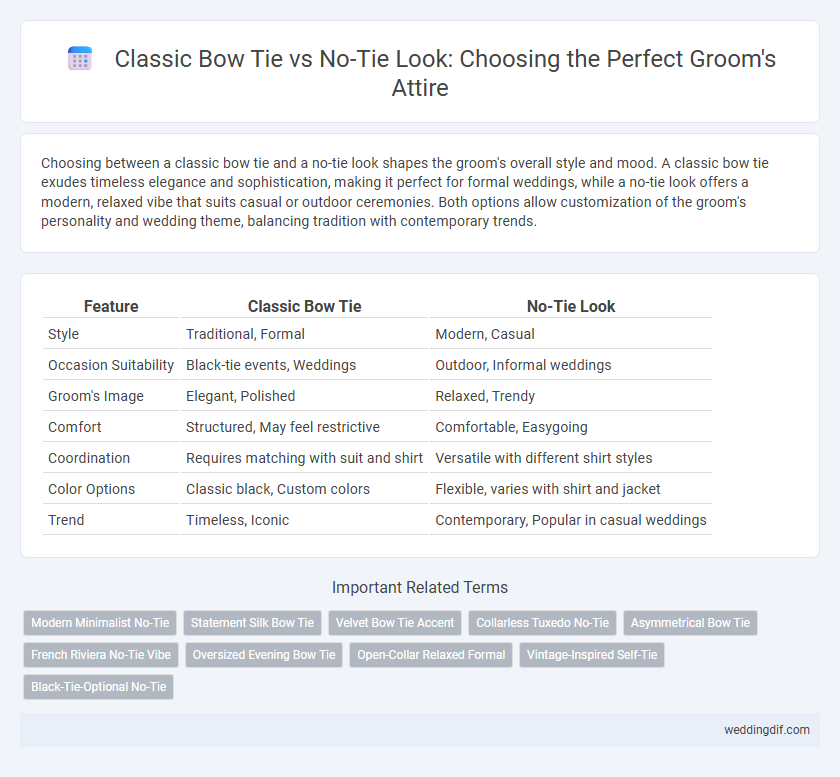Choosing between a classic bow tie and a no-tie look shapes the groom's overall style and mood. A classic bow tie exudes timeless elegance and sophistication, making it perfect for formal weddings, while a no-tie look offers a modern, relaxed vibe that suits casual or outdoor ceremonies. Both options allow customization of the groom's personality and wedding theme, balancing tradition with contemporary trends.
Table of Comparison
| Feature | Classic Bow Tie | No-Tie Look |
|---|---|---|
| Style | Traditional, Formal | Modern, Casual |
| Occasion Suitability | Black-tie events, Weddings | Outdoor, Informal weddings |
| Groom's Image | Elegant, Polished | Relaxed, Trendy |
| Comfort | Structured, May feel restrictive | Comfortable, Easygoing |
| Coordination | Requires matching with suit and shirt | Versatile with different shirt styles |
| Color Options | Classic black, Custom colors | Flexible, varies with shirt and jacket |
| Trend | Timeless, Iconic | Contemporary, Popular in casual weddings |
Introduction: Defining the Classic Bow Tie and No-Tie Looks
The classic bow tie epitomizes timeless elegance, often crafted from silk or satin to complement formal tuxedos, symbolizing tradition and sophistication. In contrast, the no-tie look embraces modern minimalism, featuring an open-collar shirt or a dress shirt without neckwear, projecting relaxed yet polished style for contemporary grooms. Both options define distinct aesthetics in groom's attire, balancing formality and personal expression on the wedding day.
Historical Significance of Bow Ties in Wedding Fashion
Bow ties have a rich historical significance in wedding fashion, symbolizing timeless elegance and formality dating back to the 19th century. Traditionally associated with black-tie events, the classic bow tie speaks to a groom's adherence to established sartorial customs. Opting for a no-tie look embraces modern, relaxed wedding trends, contrasting the bow tie's legacy of refinement and ceremonial importance.
Modern Groom Trends: Embracing the No-Tie Look
The modern groom trend increasingly favors the no-tie look, signaling a shift towards relaxed yet polished wedding attire. Opting for open collars or sleek shirts without bow ties enhances comfort while maintaining sophistication, aligning with contemporary minimalist style. This approach offers versatile grooming options that complement both formal and casual wedding themes, making it ideal for grooms seeking a fresh, personalized statement.
Formality Factor: When Bow Ties Are Essential
Classic bow ties elevate the groom's attire by adding a distinct touch of elegance and formality essential for black-tie and formal weddings. Opting for a bow tie ensures compliance with traditional dress codes, signaling respect for the event's sophisticated ambiance. In contrast, the no-tie look suits more casual or contemporary ceremonies where relaxed style replaces strict formality.
Comfort and Practicality: No-Tie Advantages
The no-tie look in groom's attire offers superior comfort by eliminating the tightness and restriction often caused by classic bow ties, allowing greater freedom of movement throughout the wedding day. Practicality is enhanced as this style reduces the need for constant adjustment, minimizing distractions and ensuring the groom remains focused on the celebration. Embracing the no-tie approach is especially beneficial for outdoor or long-duration weddings where comfort and ease are paramount.
Style Expression: Personalizing Groom Attire
Choosing between a classic bow tie and a no-tie look allows the groom to express individuality while maintaining sophistication. A classic bow tie conveys timeless elegance and formality, ideal for traditional weddings, whereas the no-tie look offers a modern, relaxed vibe that highlights contemporary confidence. Personalizing groom attire through these choices reflects the groom's personality and complements the wedding's overall aesthetic.
Coordinating With Bride and Wedding Theme
A classic bow tie offers timeless elegance that complements traditional bridal gowns and formal wedding themes, enhancing the groom's polished appearance. The no-tie look provides a modern, relaxed style that pairs well with casual or bohemian bridal attire and outdoor or rustic wedding settings. Matching the groom's accessory choice with the bride's dress style and the overall wedding theme ensures seamless visual harmony and cohesive photographic aesthetics.
Photography: Bow Tie vs. No-Tie Aesthetics
The classic bow tie enhances the groom's attire with a polished, timeless elegance that photographs sharply, highlighting symmetrical lines and formal sophistication. In contrast, the no-tie look offers a modern, relaxed vibe, creating portraits with a natural, approachable aesthetic that captures personality over formality. Choosing between bow tie and no-tie significantly impacts the visual narrative of wedding photography, balancing tradition and contemporary style.
Venue and Season: Impact on Groom's Style Choice
The choice between a classic bow tie and a no-tie look for the groom's attire significantly depends on the venue and season, shaping the overall style and comfort. Formal indoor venues like ballrooms or historic estates often call for the timeless elegance of a bow tie, especially during colder months when layered suits enhance sophistication. Outdoor summer weddings at gardens or beach venues favor the relaxed no-tie option, offering a breezy, contemporary style that complements warmer temperatures and natural surroundings.
Conclusion: Choosing the Perfect Look for Your Wedding Day
Selecting between a classic bow tie and a no-tie look depends on the wedding's formality and the groom's personal style. A bow tie exudes timeless elegance and complements traditional black-tie weddings, while the no-tie look offers a modern, relaxed vibe suitable for casual or outdoor ceremonies. Prioritizing comfort and confidence ensures the groom's attire perfectly aligns with the wedding's atmosphere and his unique personality.
Classic Bow Tie vs No-Tie Look for Groom's Attire Infographic

 weddingdif.com
weddingdif.com